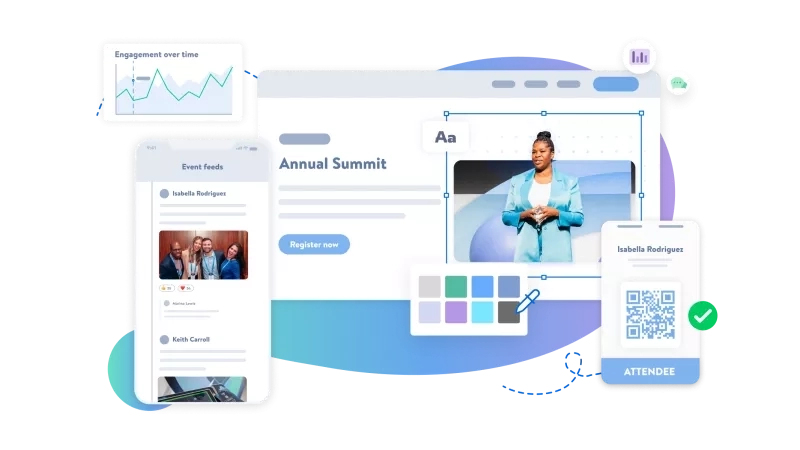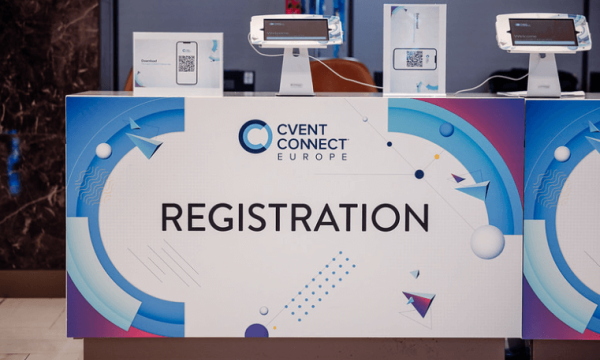Webinars: they’ve been a staple in marketers’ toolboxes for years, but they don’t always get the recognition they deserve. And yet, webinars are a highly effective way to engage with your audience and build brand.
But as any marketer knows, getting people to register and attend your webinar can feel like an uphill battle. How do you promote them effectively? How do you keep people engaged? And most importantly, how do you measure success
In this interview, Emily Dick, Director of Demand Generation at Cvent, shares how webinars help marketing teams meet their goals, how to host webinars people actually want to attend, and tips on building a scalable, results-driven webinar program.
Why webinars still work in 2025
Webinars continue to punch above their weight. According to the Content Marketing Institute, over half (51%) of B2B marketers say webinars produce the best results for their organization.
So, if webinars aren’t already a part of your marketing strategy, they probably should be.
Press ▶️ to hear more benefits of running webinars:
Emily sees several advantages, starting with cost-effectiveness. “Most people already have a webinar platform, so there's no need to spend a ton of budget to put on a high-quality webinar.”
Webinars are also incredibly scalable. “You can reach a global audience,” Emily explains. “This means you can easily expand your reach and engage with prospects and customers from all over the world."
They’re also versatile across the funnel. “You can use them for awareness, such as thought leadership and industry insights, and also deeper in the journey for product education, training, or customer engagement.”
But the real power of webinars? They’re a content anchor. As Emily explains, “They can become the epicentre of your content. You can build anticipation around your webinar’s date and time and run all of your different promotions and email strategies around it.”
How to promote webinars that convert
Press ▶️to hear more tips on how to promote your webinars:
Getting people to register for your webinar is often half the battle. Luckily, there are effective ways to promote your webinar and drive registrations.
- Email: “Email is still the number one promotional tactic for webinars,” says Emily. “For us, it supports our efforts to position ourselves as thought leaders and keeps our audiences up to date with the various topics we cover each quarter.” Start promotion four weeks out if you can.
- Website personalization: “Our website is a key part of our cross-promotion. “If you’re a customer, you might see a different pop-up or an urgency banner than a prospect or someone from a different industry.”
- Social media: “We’ve seen excellent conversions when using short video clips to promote our webinars, with 30 seconds being the sweet spot,” says Emily. “It’s really effective in getting people to share our content and reaching new audiences.”
- Paid social: “Paid promotion for webinars is more effective if you can start at least four weeks before your webinar,” says Emily. “You’ll also need to consider your budget. For those reasons, we have a threshold a webinar has to meet in terms of registrations before we will start a paid campaign for it.”
- Advocacy: Emily also recommends asking your speakers, employees, and other advocates to help promote your upcoming webinars.
3 pillars of a successful webinar strategy
1. Make planning agile
Consider mapping out your webinars quarterly, not yearly, to stay agile.
“The first step is to identify your priority webinars,” says Emily. “These are aligned with the key themes you’re going to cover. They’re your foundational cornerstones. At Cvent, we call these our marquee webinars.”
From there, Emily recommends setting a realistic cadence—what works will vary by organization, region, and team capacity. “When you’re running global webinars, different time zones mean that you may be running the same webinar at different times.”
2. Align on objectives
Scaling your webinar program gets trickier as more teams look to run their own sessions. That’s why Emily recommends putting guardrails in place to ensure every webinar aligns with strategic goals.
“Before greenlighting any webinar, it’s important to ask a few key questions,” she explains. “What’s the goal? Who’s the audience? Where does it fit in the customer journey?”
This approach helps the team stay focused on content that delivers value. But not every topic needs to be a webinar. “By asking these questions upfront, we can identify whether a topic even needs to be a webinar in the first place,” says Emily. “Sometimes a request that starts as a webinar idea ends up working better as a blog post, video, or even a podcast episode.”
3. Integrate your tech stack
Tracking is a non-negotiable part of the process and for demand gen teams, that starts with having the right systems talking to each other.
“Only a small group of people may actually live in the webinar platform, whilst other teams are in the marketing automation and CRM systems looking at things like attribution, campaign performance, and lead scoring.
“Your webinar platform should ideally be integrated into your marketing automation or CRM system so you can track those business outcomes.”
How to keep webinar audiences engaged
The best way to increase webinar engagement, Emily says, is to host them live. Why? Interaction.
“Live webinars make all the difference – it means that your presenters can engage directly with the audience,” she says. “Throw up a poll. Open the chat. Run a Q&A. All of these elements show attendees you’re there with them in the moment.”
Interacting with a live audience also lets you tailor the webinar's content based on the discussion. “If you get people chatting, your speakers can tailor curate the content of the webinar based on what your attendees are saying,” says Emily.
Tips for engaging after the webinar
“For every webinar programme I’ve ever done, we begin that post-webinar engagement straight away,” says Emily. “Even during the webinar, we’re already thinking about what the next step should be and communicating that at the end.”
Her best practice:
- Send the recording fast
- Segment ‘thank you’ and ‘no-show’ emails to those who attended and those who didn’t
- Create teaser clips from the webinar to generate FOMO and continue nurturing those who didn’t attend
“You could take the recording and create a teaser, so you’re giving FOMO to the people who didn’t attend and put them into a nurture where you can further engage them in a topic they’re interested in. The sooner you follow up, the better – it’s about engaging with your audience while you’re still top of mind.”
3 metrics to measure webinar performance
With so much potential data at your fingertips, it can be challenging to know where to focus. Emily focuses on these three coremetrics:
- Registrations: “This is the very first conversion point. We measure this because it’s a key engagement point, and you can start to nurture your audience once they’ve registered.”
- Show rate: “It’s a primary metric for any webinar program because fundamentally, we need people to attend our webinars to build further engagement.”
- Engagement: Engagement signals during the webinar include participation in chat, Q&A, and the number of questions asked. “Those things are critical to us so that we can share best practices to evolve our program and help our speakers design their presentations.”
💡 Learn more about some of the webinar metrics you should be tracking:
Whatever the KPIs you choose to track, the most critical tip is to know what you’re measuring and why.
“One of the biggest iterations we’ve made is ensuring that every type of webinar we produce has a specific set of objectives,” says Emily.
“Sometimes, the objective of a webinar may purely be engagement, not to generate MQLs (Marketing Qualified Leads) or SQLs (Sales Qualified Leads). And that is a fair objective for a webinar—as long as it’s clearly defined.
“On the flip side, I also have webinars that are strictly for generating revenue,” Emily continues. “Therefore, if they’re not doing their job, that’s easy to track and determine if we still want to do them.”
💡Learn why comparing percentages is key to understanding the performance of your webinar strategy:
4 webinar pitfalls to avoid
- Underestimating the level of effort: Hosting a great webinar takes a lot of effort. For Emily, it’s crucial to give yourself enough time to plan, prepare, and promote your webinar to ensure its success.
- Not measuring performance: “Every webinar should have a KPI to measure against,” says Emily. Without measuring performance, it's impossible to know whether your webinar was a success or not.
- Not rehearsing: “People often show up on the day of the webinar and think that they can just wing it, which isn’t the case,” says Emily. The solution: schedule a rehearsal ahead of time. “It’s worth it because you’ll get everyone to feel comfortable, and you won’t have any surprises. Speakers will also feel better after going through a dry run.”
- Not having a contingency plan: Always have a backup plan. “Something will always go wrong; perhaps your speaker is late, or their tech isn’t working. So, always have contingencies in place. That said, don’t freak out if something goes wrong because it’ll often smooth over, and your audience won’t have even noticed.”
“Webinars aren’t going anywhere,” says Emily. “But in my experience, they’ve often been the most successful when there’s a dedicated webinar owner whose KPIs are tied to webinar outcomes. That’s a key element for success.”








